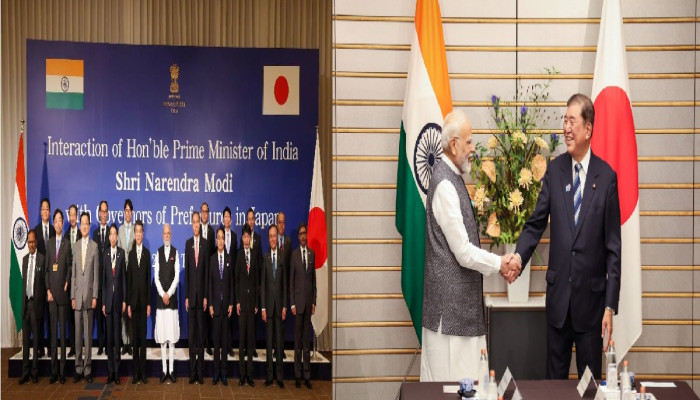A Quantum Leap in India-Japan Strategic Engagement
- In Foreign Policy
- 11:47 PM, Sep 02, 2025
- Ramaharitha Pusarla
PM Modi’s two-day visit to Japan to attend the 15th Annual India-Japan summit meeting comes amid crucial geopolitical flux. At a time when President Trump seeks to upend the world order, nations are resetting their ties to cope with the looming uncertainties. Blighted by unpredictability, nations are reexploring bilateral partnerships and seeking to anchor ties based on mutual trust and respect.
Trump’s threatening tariffs and motivated secondary sanctions have propelled nations to reshape their partnership with a transformative agenda. Ending up with a short end of the stick, Japan, the US ally since World War II, responded to India's alacrity to strengthen the bilateral ties amid looming ‘Trumpian Disorder’. With close to eight decades of establishing diplomatic ties, India and Japan have a longstanding friendship and goodwill.
Amid the ever-changing dynamics of geopolitical power games, trusted partnerships have always been pillars of stability. Positively reorienting the convergence of interests and strategic outlook, India and Japan have laid down a 10-year strategic roadmap to weather the geopolitical headwinds.
Japan has been a part of India’s journey in Viksit and Atmanirbhar Bharat. Rooted in their commitment to a free and open Indo-Pacific (FOIP), upholding the rules-based order, and seeking to elevate the old friendship, leaders have taken a quantum leap in terms of enhancing cooperation. In these tumultuous times when lack of mutual respect and tolerance to sensitivities are destabilising ties, known for its discreet diplomacy of taking up differences privately, harmonising mature relationships, India and Japan have unveiled a joint statement -“Partnerships For security and prosperity of our next generation”.
Trump’s tariff fury and volatile foreign policy have raised concerns about America’s credibility in upholding the world order and its commitments to nations. Taking its brinkmanship to the next level, the US has tried to corner India. However, turning the adversity into an opportunity, PM Modi, in his address to the India-Japan Economic Forum at Tokyo, highlighted India’s transformation, asserting, “capital in India doesn’t just grow, it multiplies”, underscoring its stable economic rating.
Reinforcing Japan Bank for International Cooperation (JBIC)’s testament to India as the most ‘promising’ investment destination, PM Modi extended an invitation to Japanese businesses to India. Be it official Development Assistance (ODA), metros, manufacturing, AI, high-speed rail, urban renewal, smart cities project, India-Japan partnership reflects mutual trust. Japanese investment, though modest ($34 billion), has great strategic weight. It is aligned with India’s long-term priorities like Make in India, Digital India, Startup India, renewable energy, and advanced manufacturing. In the last two years, the Japanese private sector has announced 150 MoUs worth $13 billion with India in automotive, energy, aerospace, semiconductors and human resources.
Experiencing decades of prolonged economic stagnation emanating from the post-Plaza Accord, leading to a period of “Lost Decades”, Japan has never recovered from the asset bubble collapse. Further, economic mismanagement, demographic decline and an ageing population have exacerbated its economic woes.
The recent trade deal with the Trump administration of lower tariff slabs in exchange for an investment pledge has further left Tokyo high and dry, with Trump claiming the package as “our money to invest, as we like”. Further, surrounded by nuclear powers, in the highly contested Indo-Pacific theatre, Trump’s wavering security pledges have spurred debate among the US allies about American willingness to come to their aid in a conflict. Ahead of PM Modi’s visit Japanese trade negotiator scrapped a US trip, delaying the finalisation of $500 billion investment plan.
Once bitten, twice shy, Tokyo is also reassessing its options on economic engagement and security. PM Modi’s assurances couldn’t have been more timely. Positioning India as a ‘stabilising power’, PM Modi said, “The world is not just watching India, it is counting on India. Japan is a tech powerhouse and India is a talent powerhouse. We both agree that as two major economies and vibrant democracies, our partnership is very important not only for our two countries, but also for global peace and stability”.
Indeed, the timing of PM Modi’s visit to Japan ahead of the Shanghai Cooperation Organisation (SCO) has a strategic imperative. Amid the perception that Trump’s tariffs have pushed India into China’s lap, the annual summit meeting with Japan is a strong signal and assurance of New Delhi’s relevance in the shifting regional balance. It is a message that the India-Japan partnership will continue to remain as a counterweight to the muscular expansionism of China.
India and Japan elevated their ties to a “Special Strategic and global partnership” in 2014, and ever since, PM Modi has travelled to Japan for the annual summits eight times. With over 70 dialogue mechanisms and working groups, countries have intensely engaged with a myriad of ministries, departments, and agencies. Building on these accomplishments and leveraging respective strengths and complementarities, both sides have identified three core areas- bolstering defence and security, reinforcing economic partnership and deepening people-to-people ties.
With unsettled territorial issues with China, South Korea and Russia, Japan is facing mounting geopolitical challenges. Given its security vulnerabilities, Japan is seeking to deepen a strategic defence and security partnership with India. As a first step, to promote interoperability and synergy between defence forces and defence capabilities. Along with exploring cooperation mechanisms for defence co-production, co-development countries are planning to promote dialogue between Joint Staffs, maritime cooperation, cooperation in counterterrorism, peacekeeping operations, cyber defence and collaboration between special operations units.
Adopting a joint vision for the next decade, countries decided on ‘whole of nation lines’ to steer partnership through eight pillars. These are next-generation economic partnership, economic security partnership, mobility, ecological legacies, technology and innovative partnerships, next-generation health, people-to-people partnership and state-prefecture partnerships.
For credible and effective implementation of the initiatives, countries have evolved an action plan for India-Japan Human Resource Exchange and Cooperation and a Joint Declaration on security cooperation. Grappling with a severe labour shortage due to declining populations, leveraging complementarities, countries rolled out an Action Plan for talent mobility and a two-way exchange of 5,00,000 personnel, including 50,000 skilled workers over a five-year time frame under 16 categories.
Being two strong democracies in the Indo-Pacific region with converging security threats, India and Japan are natural partners. The defining speech of PM Shinzo Abe, “Confluences of Two Seas”, is credited as the guiding vision for a Free and Open Indo-Pacific (FOIP).
Despite an enduring friendship, the bilateral trade is a marginal $23 billion tilted in favour of Japan. To enhance, diversify economic cooperation and make it more forward-looking, countries are reviewing the Comprehensive Economic Partnership Agreement (CEPA) signed in 2011. Leaders have set a private investment target of JPY 10 trillion ($68 billion) spread over a decade in key sectors like semiconductors, critical minerals, defence and technology.
Recognising shared interests in safeguarding critical economic interests and factoring geopolitical realities and security configurations, countries have widely expanded the arena of cooperation.
To secure and strengthen supply chains in critical goods and sectors, countries decided to accelerate cooperation in critical and emerging technologies, telecommunications, pharmaceuticals, critical minerals, semiconductors and clean energy. This heightened priority complements the existing collective partnership for resilience on semiconductors and critical minerals, through the Quad’s Supply Chain Contingency Network and Minerals Security Partnership.
Additionally, countries are working together through the Biopharmaceutical Alliance for building reliable supply chains and the India-led Global Biofuels Alliance to realise their climate change commitments.
Elevating symbolic goodwill to practical partnership, countries have signed a raft of agreements. The enormity of the aspirations and the ambitious vision set by the leaders is truly overwhelming. The Indian and Japanese Coast Guard signed a Memorandum of Cooperation. Countries have also signed MoC in Mineral Resources, Joint Crediting Mechanism and Cultural Exchange.
Countries inked a Joint Declaration of Intent on Clean Hydrogen and Ammonia (towards net zero economy) and several MoUs - India-Japan Digital Partnership 2.0, environmental cooperation, decentralised domestic waste management, diplomats' training, next generation mobility partnership, Science & Technology (first of its kind) and extended an MoU on India Beamline at the Photon Factory, KEK for six years.
Strengthening the Lunar Polar Expedition (LUPEX), countries sealed an Implementing Arrangement between ISRO and JAXA- Japan Aerospace Exploration Agency, for a landmark collaboration on Chandrayaan 5. Both sides launched the India-Japan AI initiative, and PM Modi extended an invitation to the Japanese counterpart for the Open AI Summit held in India.
At the Annual Summit, countries launched a Track 1.5 dialogue of think-tanks to promote wider appreciation of security challenges and announced an annual dialogue of National Security Advisers (NSAs). India opened a consulate in Fukuoka with plans to establish business forums in the regions of Kansai and Kyushu to strengthen business, people-to-people and cultural linkages.
India permitted Japan, the first foreign development partner, to build infrastructure projects in India’s sensitive North East region. Trust and reliability are the bedrock of the India-Japan relationship. Synchronising India’s vision of Mutual and Holistic Advancement for Security and Growth Across Regions (MAHASAGAR) with Japan’s Economic Region Initiative of Indian Ocean and Africa, countries plan to invigorate business collaborations in South Asia and Africa. This arrangement can serve as a challenger to China’s BRI and counterbalance Beijing’s posturing as the leader of the ‘Global South’.
Alongside, to foster political trust, the State-Prefecture relationships are established between UP and Yamanashi, AP and Toyama, TN and Ehime, Gujarat and Shizuoka, with high-level exchanges between states and prefectures, including three visits in each direction, being explored. Countries also launched the India-Japan SME Forum and issued the Economic Security Factsheet outlining ongoing collaborations in strategic sectors.
The bilateral talks, which lasted for over two hours, apart from reviewing the bilateral cooperation, focused on regional and global issues. Countries expressed concerns over the situation in the East China Sea and South China Sea. They opposed unilateral action that endangers the freedom of navigation and overflight, a change in the status quo, and called for dispute resolution in accordance with the UN Convention on the Law of the Sea (UNCLOS). They condemned the Pahalgam attacks and took note of the UNSC Monitoring Report's mention of the Resistance Front (TRF), condemned nuclear aspirations of North Korea and destabilising missile testing, the worsening situation in Myanmar and urged a return to democracy. They welcomed the Israel-Iran ceasefire, expressed support for a just and lasting peace in Ukraine, and supported each other’s candidature for a seat on the UNSC.
PM Modi concluded his trip with a visit to Tokyo Electron Factory, the leading semiconductor equipment manufacturer in Miyagi prefecture, by train, accompanied by PM Shigeru Ishiba. Later, PM Modi addressed a group of governors from prefectures.
Amidst a rapidly evolving and volatile geopolitical landscape, India and Japan are consolidating the old partnership, imparting a strategic dynamism. Infusing new vigour into the longstanding friendship, countries are gearing up to navigate global challenges together. Demonstrating a new resolve and shared commitment, countries are actively seeking new avenues to harness their complementary strengths. With a focus on unlocking the untapped potential, leaders are ushering the partnership into a new phase for tangible benefits and mutually beneficial outcomes.
References
- 15th India-Japan Annual Summit Joint Statement: Partnership for Security and Prosperity of our Next Generation (August 29, 2025)
- Action Plan for India - Japan Human Resource Exchange and Cooperation (August 29, 2025)
- India - Japan Joint Vision for the Next Decade: Eight Directions to Steer the Special Strategic and Global Partnership (August 29, 2025)
- https://www.mea.gov.in/bilateral-documents.htm?dtl/40066/Fact_Sheet__IndiaJapan_Economic_Security_Cooperation
- Joint Declaration on Security Cooperation between India and Japan (August 29, 2025)
- List of Outcomes: Prime Minister’s Visit to Japan (August 29 – 30, 2025)
- Transcript of Special briefing by MEA on Prime Minister’s visit to Japan (August 29, 2025)
Disclaimer: The opinions expressed within this article are the personal opinions of the author. MyIndMakers is not responsible for the accuracy, completeness, suitability, or validity of any information on this article. All information is provided on an as-is basis. The information, facts or opinions appearing in the article do not reflect the views of MyindMakers and it does not assume any responsibility or liability for the same.







Comments